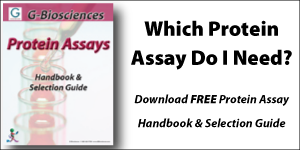Question:
What assays are used in protein concentration determination?
The Protein Man Says:
Due to the fact that there are no protein assays that are specific to any particular protein or are sensitive to all types of proteins, it is absolutely impossible to have a single assay that can give absolutely accurate results when performing protein concentration determination. Despite the apparent limitations, however, it is very much possible to choose one that is compatible with your sample.
 To find protein assays that are most compatible with your sample, you need to consider their compatibility with the sample type and its components, the assay range and the required sample volume and protein-to-protein uniformity. You may also need to consider the speed and convenience by which the samples need to be tested and the availability of spectrophotometer or plate reader. Some of the protein assays currently being used in laboratories include the Lowry assay, the Bradford assay, the BCA assay and UV absorbance at 280 nm.
To find protein assays that are most compatible with your sample, you need to consider their compatibility with the sample type and its components, the assay range and the required sample volume and protein-to-protein uniformity. You may also need to consider the speed and convenience by which the samples need to be tested and the availability of spectrophotometer or plate reader. Some of the protein assays currently being used in laboratories include the Lowry assay, the Bradford assay, the BCA assay and UV absorbance at 280 nm.
Of these methods, the UV absorbance is by far the simplest and the most direct. It can be used to estimate protein concentration prior to using a more accurate method and is quite useful in monitoring the absorbance of aromatic amino acids, tryptophan and tyrosine. It can also be used to measure the absorbance of peptide bonds if the wavelength is lowered. However, the results may highly be affected by the pH and ionic concentration of the solution and contamination.
The Lowry assay, on the other hand, is the most commonly referenced method for protein concentration determination. It is sensitive over a wider range, can be performed at room temperature and is about 10 to 20 times more accurate than UV detection. However, it can also be susceptible to a number of compounds used in buffer and cell lysate preparation, exhibits photosensitivity and is time and labor-intensive.
Considering these limitations, most laboratories prefer to use Bradford and BCA protein assays since both are very sensitive, compatible with a wide range of substances and give fast results. These assays also complement each other thereby allowing researchers to accommodate more samples.
Image By: the_himay







